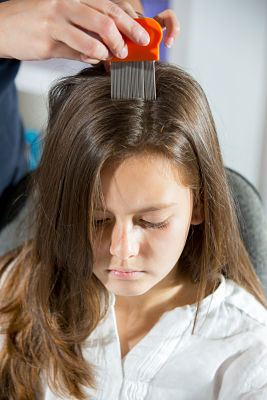
A little girl looking down while someone combs through her hair to check for lice
Lice
Lice are tiny insects that live on humans and feed on blood. When a large number of lice live and multiply on a person, it is called an infestation.Lice are very easily spread, usually through close personal contact and human to human. Pets don't get head lice and can't spread them to humans.
*Head lice may be spread through shared personal items (combs, brushes, hats, helmets, clothing, or earphones).
*Body lice are most often spread by contact with personal items, especially clothing and hats. They are sometimes spread by direct personal contact.
Itching, the most common symptom of all types of lice infestation, is caused by an allergic reaction. Lice bite the skin to feed on a person's blood. The saliva from these bites caused the allergic reaction and itching.
Head lice and their eggs (nits) can be seen on hair, the nape of the neck, and behind the ears. They can vary in color from white to brown to dark gray. The eggs are tiny round or oval shapes that are tightly attached to the hair near the scalp and do not slide up and down on the hair.
Frequent scratching may cause broken skin or sores to form on the scalp. The damaged skin may weep clear fluid or crust over, and it may become infected. In response to infection, the lymph nodes behind the ears and in the neck may become tender and swollen.
Lice will not go away without treatment. The most common treatment is an over-the-counter or prescription cream, lotion, or shampoo. You put it on the skin or scalp to kill the lice and eggs. In come cases, you may need treatment a second time to make sure that all the eggs are dead. If two or more treatments don't work, your doctor may prescribe a different medicine. It's also important to wash clothing and bedding in hot water to help get rid of lice.
